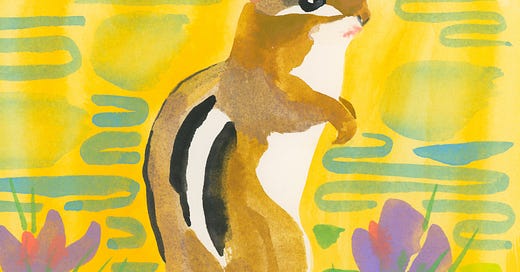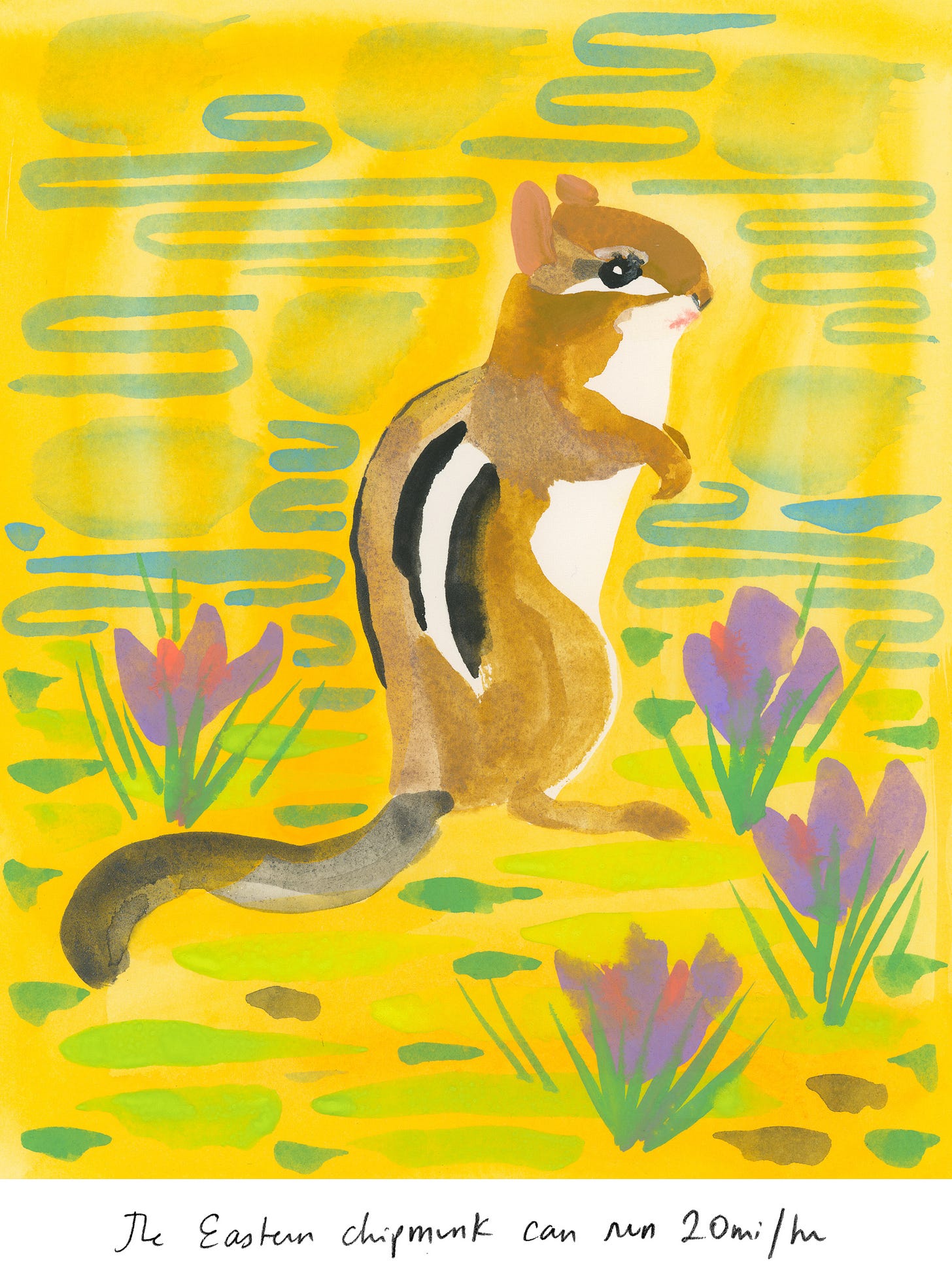Hi, friends — we’ve made it halfway to summer! — welcome to issue #18 of my newsletter about animal encounters. These little creatures (Tamias striatus) are like my inner voice, constantly chattering away, weighing options, diving under rocks. As always, I’d love to hear your stories. Please share online or you can always reply to this email. Thanks! — AJP
This week has been cold and bleak, the trees and sky the color of earthworms (yes, that gray). We live on top of a rock, carved by some old glacier, and over the years have learned it’s something of a microclimate—twenty minutes in any direction and there are likely crocuses. But here, under still-dormant trees, the slate is bare. (Except!) Except that I saw my first chipmunk of the year.
Eastern chipmunks are ubiquitous in Connecticut. In every rock wall, beneath every fallen tree, they hide anxiously, awaiting a safe moment in the sun. There are usually a few per acre, and each year we have our heroes: the one I always surprise under the big boulder, where I’m constantly hacking at the roots of a burning bush (I never seem to get them all); the one under the rock wall, making it seem like rocks have eyes; the one that tunnels under the house by the azalea, another by the evergreen, another under the oil tank.
To the first chipmunk of the year I yelled, “Hey Chippie!” I really only caught a glimpse of its tail, scurrying back to safety. Mainly they run, fast, but sometimes they make that distinctive animal calculation of standing extremely still. Sometimes, I’ve been very, very close to a chipmunk, standing very, very still. In these moments, I appreciate the beauty of their black stripes and bandit eyes—they really are exquisite.
Chipmunks breed twice a year—now, in mid-March, and later in July. Gestation is about a month, so, by the beginning of May, the world under our feet will be full of baby chipmunks. Mothers raise their young on their own, usually four or five pups per litter. Youth isn’t long for chipmunks, who leave their mother’s burrow within a couple of months, establishing their own burrow nearby.
Chipmunks are antisocial creatures, living alone in their little system of underground chambers (including a sleeping room the size of a basketball, plus a bathroom, and food room, for example). They excavate and move dirt by carrying it in their mouth pouches and depositing it inconspicuously away from their front door, though they prefer to work within old tunnels and root systems.
Chipmunks defend their territory from other chipmunks, and I’ve definitely seen the fracas and fallout of their chasing and yelling. It always ends quickly though. They have a solid set of vocalizations, of “chips” and “chucks,” and I often hear them when I’m walking by. They will even join together in a kind of choral warning system. Birds take note and understandably set up their nests elsewhere.
The Eastern chipmunk is thought to be one of the most primitive living squirrels, having originated over 20 million years ago. It makes me wonder about my favorite chipmunk under the big boulder, if it is related to the chipmunk that was under the same boulder one, two, ten million years ago? It is a comfort to know and think about this long view, as spring inches slowly into place.
Eastern chipmunk links—
Great short video from PBS with footage of a chipmunk’s underground home, plus a chipmunk battle in slow motion, plus one stuffing its face. [PBS]
Nuts! Nuts! Nuts! I love reading about the status of their foraging—one chipmunk had 70 sunflower seeds in its pouches! Another had 48 cherry pits! Here’s another one stuffing its wee face. [Warning: this is harmless but kind of gross, at The Dodo]
Hey Chippie! Here’s a poised vocal act I enjoyed very much. [YouTube]
National Geographic fitted tiny microphones on a few chipmunks to listen in on their vocalizations. [National Geographic]
There are 23 species of chipmunk in North America (the Eastern is the largest), and then there is the Siberian chipmunk. They need 13 lbs (6 kg) of stored food for the long winter. Here’s a nice short video of one stuffing its face at Britannica.
Animal encounters in recent comments—
Shrew trails in Vermont! Cat vs shrews in Oregon! Thank you so much for sending in your stories.
Also—
Next week: we’re closing in on the Full Worm Moon on March 28, so I’m tempted to consider the earthworm. And yet I can’t imagine drawing one. Tune in next week to find out what happens.
Yellow Chippers drawing is for sale; please let me know if you’re interested. I’ll send some of the proceeds to the Clean Air Task Force.
Finally, here’s a fox to celebrate the Spring Equinox tomorrow, March 20. It is a Spring Equinox Fox:
Thank you for reading and sharing with friends and family. This newsletter is a small weekly adventure about the life around us. See you next Friday.







"a sleeping room the size of a basketball" ... love it
From Lauren, writing about chipmunks in Michigan:
I have a love/hate relationship with chipmunks. They are such cheery little animals that are constantly busy. Yet, one house in MI that I lived in they became the bane of my existence. The neighborhood was full of chipmunks. The house backed up to multiple other houses that all had chain-link fences. “My” chipmunk would sit under my window, every Saturday morning-early, and bark at the chipmunks in the other yards. And they would bark back! They were so loud and insistent And they also ate my succulents. But, other than that experience, I really do enjoy watching them gather food and run about.